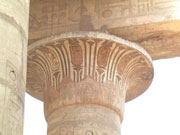TOUR NEWS -
WESTERN DESERT OASES TOUR OF EGYPT JANUARY-FEBRUARY 2010
WESTERN DESERT OASES TOUR OF EGYPT JANUARY-FEBRUARY 2010
The February 2010 tour of the Western Desert Oases of Egypt was a great success. Our travels took us to Alexandria and along the Mediterranean coast, then down to Siwa Oasis and through the other oases until we reached the hustle and bustle of Luxor. The weather was superb and for most of the trip there was a wonderful sense of being away from the modern world, since we rarely saw another tourist. The group included: Anna Johnson, Margaret Gaydon, Colin Sheppard, Margaret Debenham, Elizabeth Anderson, Karen Hoare, Tim and Shane Woodburn, Robert and Robin Callister, Alex Kennedy and Kerry Lapworth. The program was led by Dr Michael Birrell, and our Egyptian guide was Mr Mohamed Aziz.
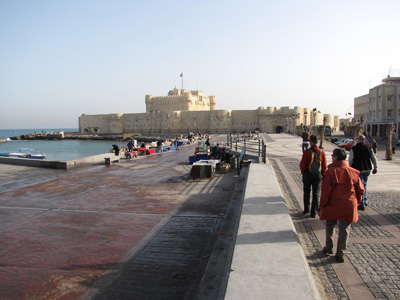 |
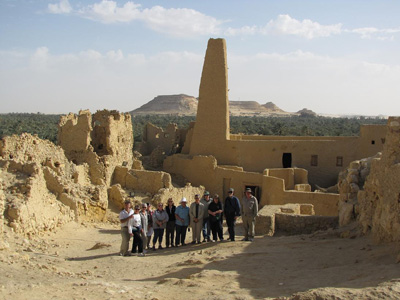 |
Fort Qaitbey, Alexandria harbour |
The group tour the Aghurmi ruins, Siwa Oasis |
Our flight on Singapore Airlines left Australia in the afternoon of the 26th January and we had a short stop over in Singapore. We arrived in the early morning of the 27th January and travelled north by bus directly to Alexandria, stopping briefly for a reviving coffee. After checking into our hotel (the Windsor Hotel on the seaside overlooking the harbor) we had some lunch at the Triannon Caf�. We then visited the new Museum of antiquities in Alexandria, home to a superb collection of sculpture including items from the recent harbour excavations. In the late afternoon we saw the new Library of Alexandria, a wonder of 21st Century architecture. We saw a beautiful sunset and had dinner on the terrace of our hotel overlooking the bay towards Fort Qaitbay.
The following morning was spent exploring the ruins of Alexandria: we saw the superb remains of Fort Qaitbey, the site of the ancient Lighthouse of Alexandria, the remarkable remains of the Kom es-Shuqqafa Necropolis which was built in the Roman Period and include relief sculpture showing the funerary god Anubis dressed as a Roman Centurion, the ancient Serapeum Temple site and in the afternoon we saw the Kom ed-Dikka Roman Theatre. Some of us went to see the Ptolemaic tomb remains in the French Cemetery often ascribed to the tomb of Alexander - and the Ptolemaic tombs at Anfushi. In the evening we had a pleasant fish dinner in a restaurant overlooking the harbour.
On the 29th January we headed west by bus along the Mediterranean coast. We stopped to see the Ptolemaic Temple of Osiris and Tower tomb at Taposiris Magna and experienced the spectacle of seeing Zahi Hawass (Director of the Supreme Council of Antiquities and media personality) filming a new documentary. He was very gracious and shook each of our hands. From here we headed to the World War II battle site of El Alamein where we saw the fascinating War Museum with its battle memorabilia and walked through the Commonwealth War Cemetery. In the afternoon we headed inland towards the Sahara, arriving at our hotel in Siwa Oasis in the evening. There was a superb full moon spreading light across the desert as we arrived.
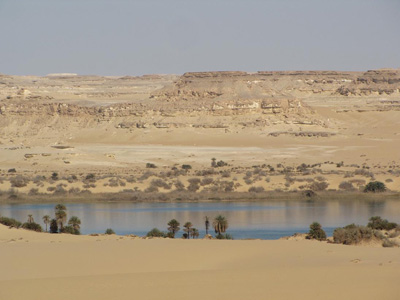 |
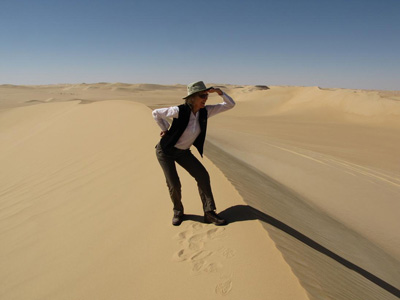 |
The beauty of Swia - Shiata pool |
Exploring the Great Sand Sea near Siwa |
The next two days were spent in the area of Siwa Oasis. We spent the morning of the 30th January exploring the picturesque remains of the 13th Century mudbrick fortress of Shali - there was a superb view of the entire oasis from the summit. We then explored the painted Pharaonic tombs at Gebel Mawta �Hill of the Dead� and after lunch saw the romantic remains of the settlement of Aghurmi where Alexander the Great consulted the famous Oracle of Amun. There were beautiful views of the Oasis in every direction from the terrace. The following day we headed out into the Great Sand Sea by 4-wheel drive to explore a magnificent area of dunes. We saw vast open desert, oasis lakes, beds of fossil shells and in the late afternoon we visited Bir Wahed for a dip in the hot spring.
 |
 |
Hot springs at Bir Wahed |
The desert road to Bahariya Oasis |
On the 1st February we left Siwa Oasis by 4-wheel drive heading east across the open desert to Bahariya Oasis. We stop to see the dramatic landscape of Sitra Oasis and saw the pools of Nuwamisa Oasis, located on the edge of the Great Sand Sea. The trip took us through dramatic desert landscapes on our 340 km trip to Bahariya Oasis. In the evening we checked into our hotel, the International Hot Springs, located in Bawiti, the main town of the oasis. The next day we explored some of the historical sites of Bahariya Oasis. We saw the local Museum which houses the famous �Golden Mummies� of the Ptolemaic and Roman Periods (discovered in the 1990�s), the remains of the Temple of Alexander and the 26th Dynasty Chapels of Ain el-Muftella. In the afternoon we visited the attractive painted tombs of Zed-amun-ef-ankh and Bannentiu.
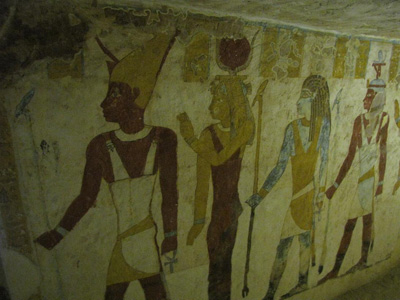 |
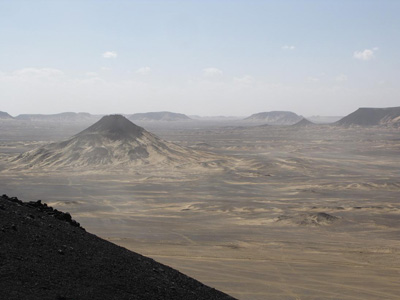 |
The tomb of Bannentiu in Bahariya Oasis |
The stark beauty of the Black Desert in Bahariya |
On the 3rd February we undertook a 90km journey south to Farafra Oasis. In the morning we stopped to see the �Black Desert�, an area of basalt formations - a magnificent view was had from the top of the plateau. We had lunch near �Crystal Mountain�, an area of quartz outcroppings, and then explored the stunning White Desert. This is an otherworldly region of wind-carved limestone formations. I saw a fennec fox while exploring the area! In the late afternoon we drank some French champagne while watching the sun set over a surreal landscape - perfect! We camped overnight and enjoyed a chef-cooked meal - a superb night sky and warm evening made for a very pleasant experience.
 |
 |
The superb �White Desert� of Farafra Oasis |
A desert fox in the White Desert of Farafra Oasis |
The next morning we explored more of the natural beauty of the White Desert before heading to Bir Sitta in Farafra Oasis for a soak in the hot springs. After checking into our hotel (the Badawiya) there was free time to visit the Badr Museum gallery, go for a walk, or relax. On the 5th February we travelled by bus to Dakhleh Oasis, a distance of about 250km. The road passed through scenic desert country with dramatic landscapes and cliffs as we enter the Oasis. We had some lunch at the Old Mediaeval City of Qasr and toured the fascinating winding streets, saw old olive and flour mills and explored houses with carved wooden doors. The view from the old minaret was superb! In the evening we checked into our hotel in Mut, the capital of Dakhleh.
Our next day was spent looking at the antiquities of western Dakhleh. In the morning we saw the picturesque ruins of the Roman temple of Deir el-Haggar, built by the Roman Emperor Nero, set in a stunning desert landscape. We had lunch in Mut and walked around the old town, saw the small Ethnographic Museum and the ruins of the Temple of Seth. In the afternoon some members of the group took a relaxing hot spa in the hotel sulphur springs. On the 7th February we checked out of the hotel and headed east to visit the fascinating mastaba tombs of the Old Kingdom at Qilat ed-Dabba. We then had the unexpected opportunity to see the French excavations at Ain Asil - this is a fascinating urban site dating from the 6th Dynasty including the Governor�s Palace. We then saw the unspoiled village of Balat which retains much of its medieval character and had some lunch. From here we went to Bashendi where we saw the tomb of a local Muslim Saint and the Roman Tomb of Kitnes, and also stopped to see some early rock-art. In the afternoon we headed 190 km east to Kharga Oasis, stopping to see some spectacular barkhan dunes. In the evening we celebrated Shane�s birthday with an enormous cake.
Over the next few days we saw the wonderful cultural heritage of Kharga Oasis. We stopped to see the Late Period Temple of Amun at Hibis, currently undergoing major restoration. We explored the remarkable Christian tombs at el-Bagawat, saw a medieval monastery, and had a brief look at the Roman Temple of Nadura located on a hill to the north of the town. The following day we visited the fascinating Kharga Archaeological Museum which preserves artefacts from all of the Oases of the western desert.
 |
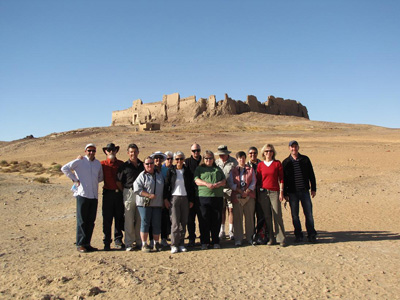 |
The medieval town of Qasr in Dakhelah Oasis |
The February group explores Qasr el-Guieta Roman fort |
On the 10th Feburary we explored some of the wonderful antiquities along the Darb el-Arba�en, the �40 Day Track� which leads down into the Sudan. In the morning we spent some time investigating the superb Late Period and Roman temple of Qasr el-Ghueita which is located in an impressive fortress. The view across the desert is magnificent! Nearby we stopped to see the picturesque Qasr ez-Zayyan Temple which dates to the Ptolemaic Period. In the afternoon we headed to the southern end of Kharga Oasis. Here we enjoyed the stark landscape of the Sahara and the romantic ruins of Qasr el-Dush, a fort and temple at the southern frontier of the Roman Empire.
The next day saw us travel out of the Western Desert as we climbed up the Oasis escarpment and headed east across the open desert to Luxor. The landscape includes stark mountain plateaus and the broad sweep of the desert. We saw a remarkable dust devil which crossed the road in front of us, a sign that we were leaving his domain perhaps! We checked into the Mercure Hotel in central Luxor and after lunch we visited Luxor Temple where we saw the superb sculpture and relief.
The following day was free to explore Luxor. A number of members of our group managed to do a whirl-wind tour of the antiquities, getting into most of the major sites. In the evening we caught our flight to Cairo. The next morning we went to the American University Bookshop to get the latest publications. We then had an extended visit to the Cairo Museum, famous for its remarkable collection of artefacts. We used the new headphones provided by the Museum which makes life much easier for everyone concerned. Later in the day we visited the Khan el-Khalili markets and had a pleasant lunch in a new restaurant. On our last evening we had dinner at the Felfela restaurant in town, a famous institution in Cairo and renowned for its Egyptian cuisine.
The Oasis Tour was a wonderful program with a very enthusiastic and interested group. We had absolutely perfect weather almost the entire time which certainly made the experience very relaxed and comfortable. The program covers all the major antiquities of the Western Desert and enabled us to also explore the natural wonders of the region - I can�t wait to lead the program again!
Michael Birrell
